ECO mode Citroen C4 PICASSO RHD 2013 1.G Owner's Manual
[x] Cancel search | Manufacturer: CITROEN, Model Year: 2013, Model line: C4 PICASSO RHD, Model: Citroen C4 PICASSO RHD 2013 1.GPages: 420, PDF Size: 9.66 MB
Page 3 of 420
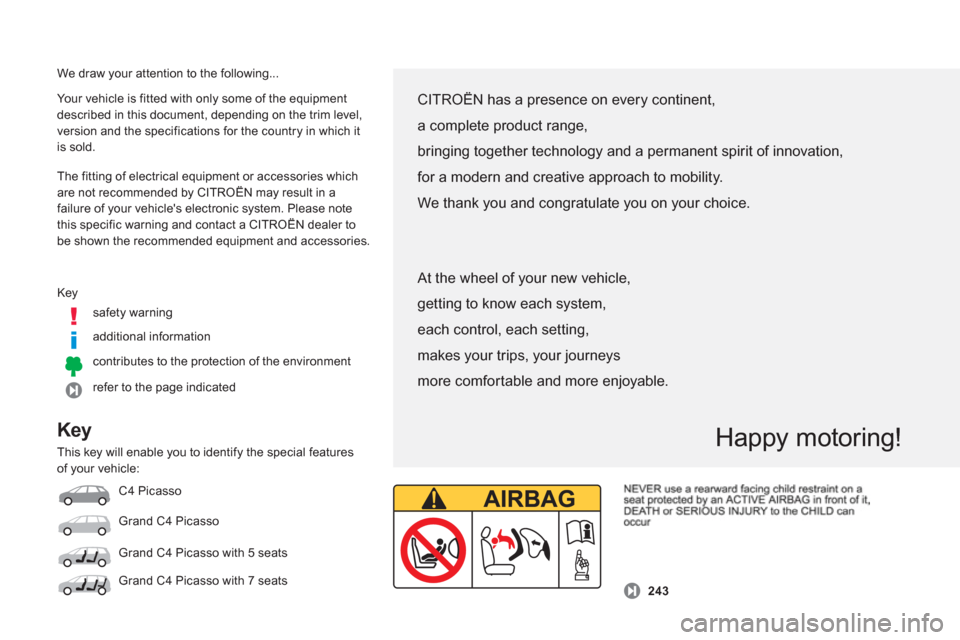
We draw your attention to the following...
Key
safety warning
additional information
contributes to the protection of the environment
re
fer to the page indicated Your vehicle is
fitted with only some of the equipmentdescribed in this document, depending on the trim level,
version and the specifications for the country in which it
is sold.
The
fitting of electrical equipment or accessories which
are not recommended by CITROËN may result in a
failure of your vehicle's electronic system. Please note
this specific warning and contact a CITROËN dealer to be shown the recommended equipment and accessories.
CITROËN has a presence on every continent,
a complete product range,
bringing together technology and a permanent spirit of innovation,
for a modern and creative approach to mobility.
We thank you and congratulate you on your choice.
Happy motoring!
At the wheel of your new vehicle,
getting to know each system,
each control, each setting,
makes your trips, your journeys
more comfortable and more enjoyable.
Key
This key will enable you to identify the special features
of your vehicle:
C4 Picasso
Grand C4 Picasso
Grand C4 Picasso with 5 seats
Grand C4 Picasso with 7 seats 243
Page 5 of 420
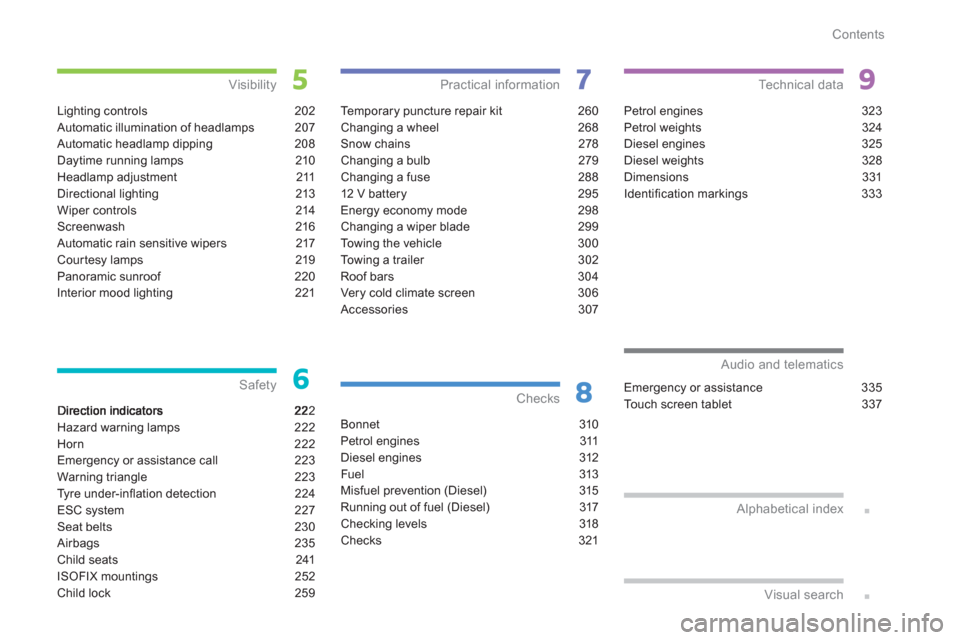
Contents
2
Hazard warning lamps 222
Horn 222
Emergency or assistance call 223
Warning triangle 223
Tyre under-infl ation detection 224
ESC system 227
Seat belts 230
Airbags 235
Child seats 241
ISOFIX mountings 252
Child lock 259
Safety
Te m p o r a ry puncture repair kit 260
Changing a wheel 268
Snow chains 278
Changing a bulb 279
Changing a fuse 288
12 V battery 295
Energy economy mode 298
Changing a wiper blade 299
To w i ng the vehicle 300
To w i ng a trailer 302
Roof bars 304
Very cold climate screen 306
Accessories 307
Practical information
Bonnet 310
Petrol engines 311
Diesel engines 312
Fuel 313
Misfuel prevention (Diesel) 315
Running out of fuel (Diesel) 317
Checking levels 318
Checks 321
Checks
Petrol engines 323
Petrol weights 324
Diesel en
gines 325
Diesel weights 328
Dimensions 331
Identifi cation markings 333
Technical data
Emergency or assistance 335
Touch screen tablet 337
Audio and telematics
Visual search
Lighting controls 202
Automatic illumination of headlamps 207
Automatic headlamp dipping 208
Daytime running lamps 210
Headlamp adjustment 211
Directional lighting 213
Wiper controls 214
Screenwash 216
Automatic rain sensitive wipers 217
Courtesy lamps 219
Panoramic sunroof 220
Interior mood lighting 221
Visibility
Alphabetical index
Page 24 of 420
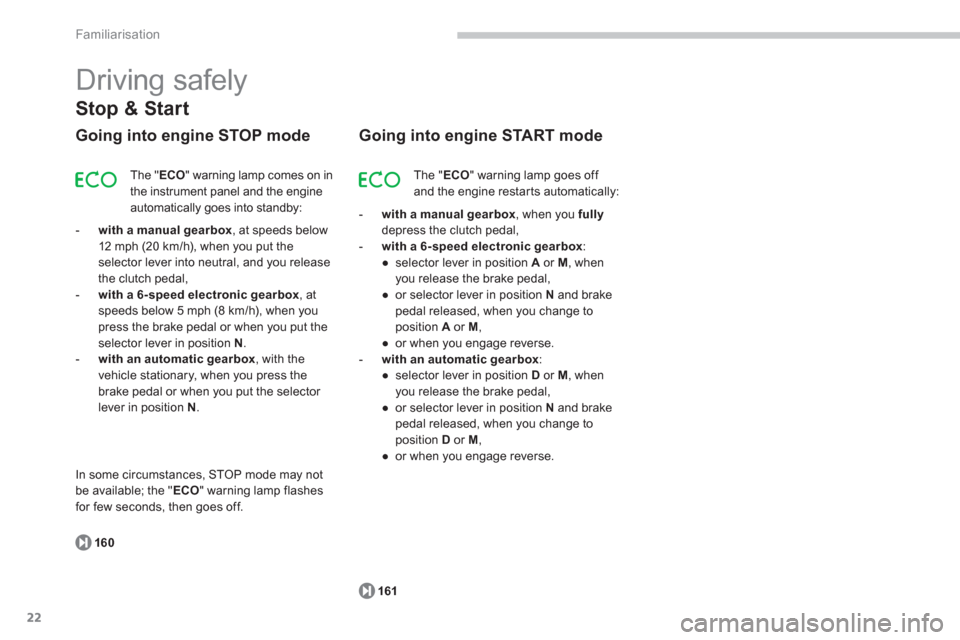
22
Familiarisation
Stop & Start
Going into engine STOP mode
The "ECO" warning lamp comes on in
the instrument panel and the engine
automatically goes into standby:
-with a manual gearbox , at speeds below
12 mph (20 km/h), when you put the
selector lever into neutral, and you release
the clutch pedal,
- with a 6-speed electronic
gearbox, at
speeds below 5 mph (8 km/h), when youpress the brake pedal or when you put the
selector lever in position N.-with an automatic gearbox , with the
vehicle stationary, when you press the
brake pedal or when you put the selector
lever in position N.
In some circumstances, ST
OP mode may not
be available; the " ECO" warning lamp flashes
for few seconds, then goes off.
160
Going into engine START mode
The "ECO" warning lamp goes off
and the engine restarts automatically:
-with a manual gearbox, when you fullydepress the clutch pedal,-with a 6-speed electronic gearbox:
●
selector lever in position Aor M
, when
you release the brake pedal,
●
or selector lever in
position Nand brake
pedal released, when you change to
position Aor M ,
●
or when you engage reverse. -with an automatic gearbox:
●
selector lever in position Dor M
, when you release the brake pedal,
●
or selector lever in position Nand brake
pedal released, when you change to
position Dor M ,
●
or when you engage reverse.
161
Driving safely
Page 25 of 420
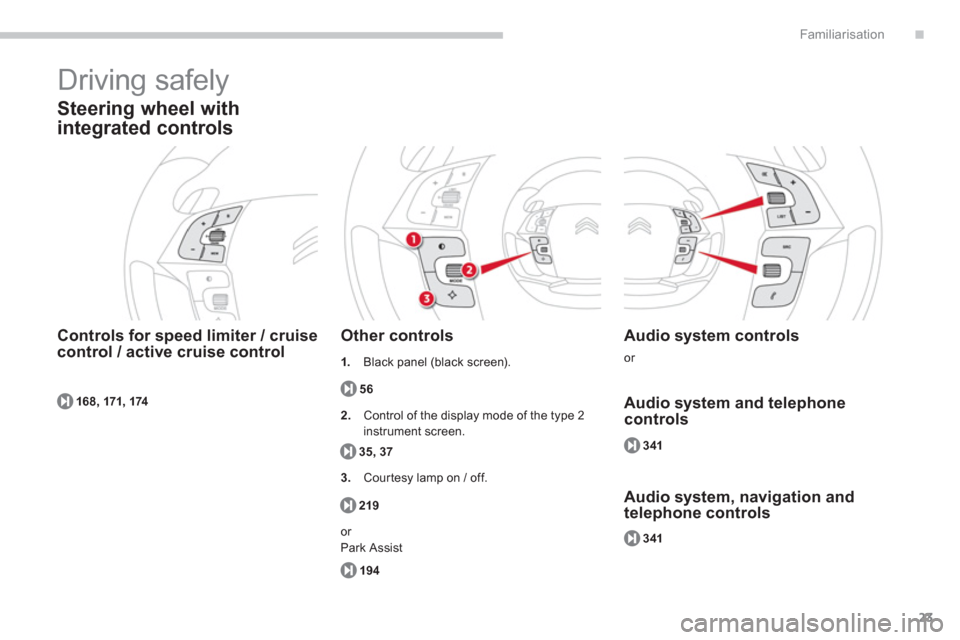
.
23
Familiarisation
168, 171, 174
Driving safely
Steering wheel with
integrated controls
Controls for speed limiter / cruisecontrol / active cruise controlOther controls
56
Audio system controls
or
Audio system and telephonecontrols
Audio system, navigation and telephone controls
35, 37
21
9
194
341
341
1.Black panel (black screen).
2
. Control of the display mode of the type 2
in
strument screen.
3. Courtesy lamp on / off.
or
Park Assist
Page 26 of 420
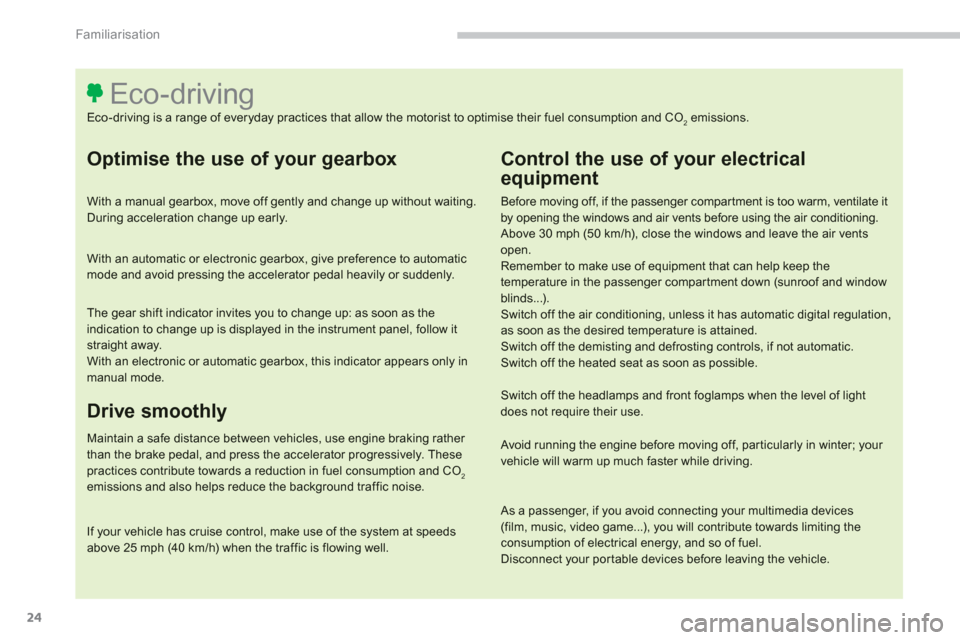
24
Familiarisation
Optimise the use of your gearbox
With a manual gearbox, move off gently and change up without waiting. During acceleration change up early.
With an automatic or electronic gearbox, give preference to automatic mode and avoid pressing the accelerator pedal heavily or suddenly.
Control the use of your electrical
equipment
Before moving off, if the passenger compartment is too warm, ventilate it by opening the windows and air vents before using the air conditioning.
Above 30 mph (50 km/h), close the windows and leave the air ventsopen.
Remember to make use of equipment that can help keep the temperature in the passenger compar tment down (sunroof and windowblinds...).
Switch off the air conditioning, unless it has automatic digital regulation,as soon as the desired temperature is attained.
Switch off the demisting and defrosting controls, if not automatic.
Switch off the heated seat as soon as possible.
Switch off the headlamps and front foglamps when the level of lightdoes not require their use.
Avoid running the engine before moving off, par ticularly in winter; your vehicle will warm up much faster while driving.
As a passenger, if you avoid connecting your multimedia devices (film, music, video game...), you will contribute towards limiting the
consumption of electrical energy, and so of fuel.
Disconnect your por table devices before leaving the vehicle.
Eco-driving
Eco-driving is a range of everyday practices that allow the motorist to optimise their fuel consumption and CO2 emissions.
Drive smoothly
Maintain a safe distance between vehicles, use engine braking rather than the brake pedal, and press the accelerator progressively. These practices contribute towards a reduction in fuel consumption and CO2emissions and also helps reduce the background traffic noise.
If your vehicle has cruise control, make use of the system at speedsabove 25 mph (40 km/h) when the traffic is flowing well.
The gear shift indicator invites you to change up: as soon as theindication to change up is displayed in the instrument panel, follow it straight away.
With an electronic or automatic gearbox, this indicator appears only in manual mode.
Page 36 of 420
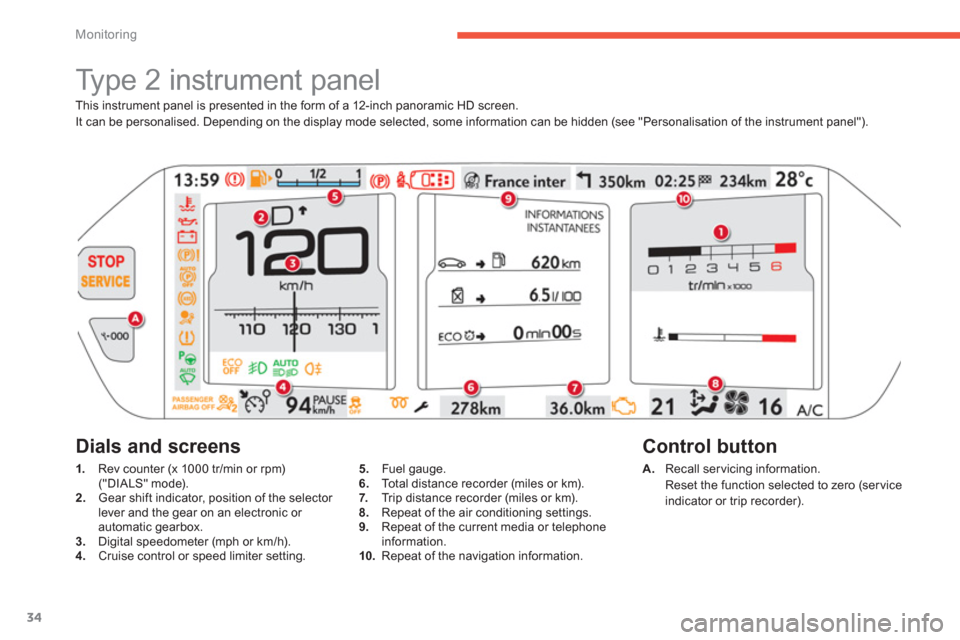
34
Monitoring
This instrument panel is presented in the form of a 12-inch panoramic HD screen.
It can be personalised. Depending on the display mode selected, some information can be hidden (see "Personalisation of the instrument panel").
Type 2 instrument panel
1.
Rev counter (x 1000 tr/min or rpm) ("DIALS" mode).2.
Gear shift indicator, position of the selector lever and the gear on an electronic or automatic gearbox.3.Digital speedometer (mph or km/h).4.
Cruise control or speed limiter setting. A
.Recall servicing information.
Reset the function selected to zero (service
indicator or trip recorder).
Control button Dials and screens
5.Fuel gauge.
6. Total distance recorder (miles or km).
7.Trip distance recorder (miles or km).8. Repeat of the air conditioning settings. 9.Repeat of the current media or telephone
information.
10. Repeat of the navigation information.
Page 39 of 420
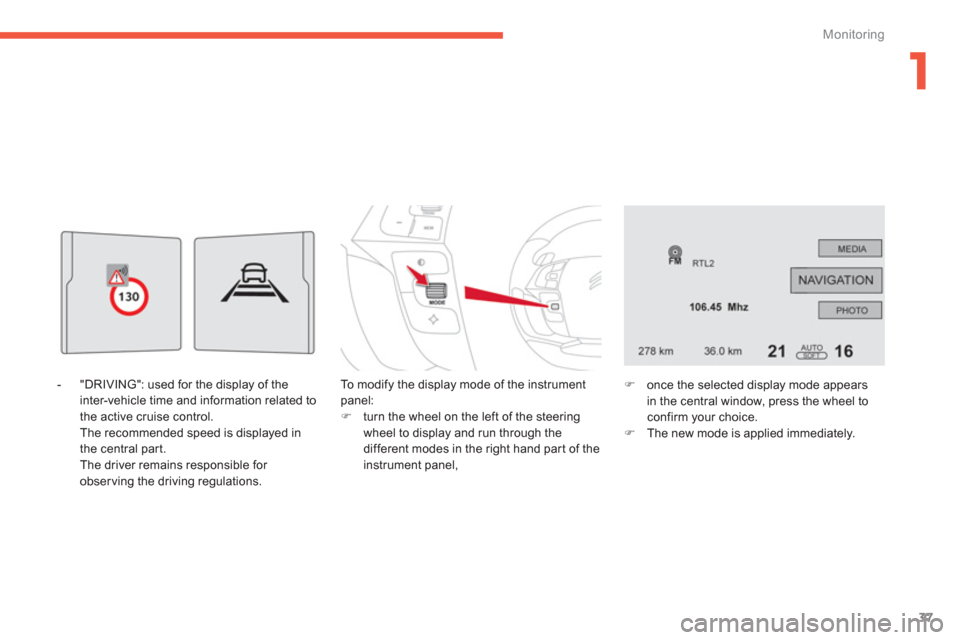
1
37
Monitoring
- "DRIVING": used for the display of the
inter-vehicle time and information related tothe active cruise control.
The recommended speed is displayed in
the central part.
The driver remains responsible fo
r
observing the driving regulations. To m o d i
fy the display mode of the instrument panel:�) turn the wheel on the left of the steering
wheel to display and run through the
different modes in the right hand part of the
instrument panel,
�) once the selected display mode appearsin the central window, press the wheel to confirm your choice. �)
The new mode is applied immediately.
Page 40 of 420
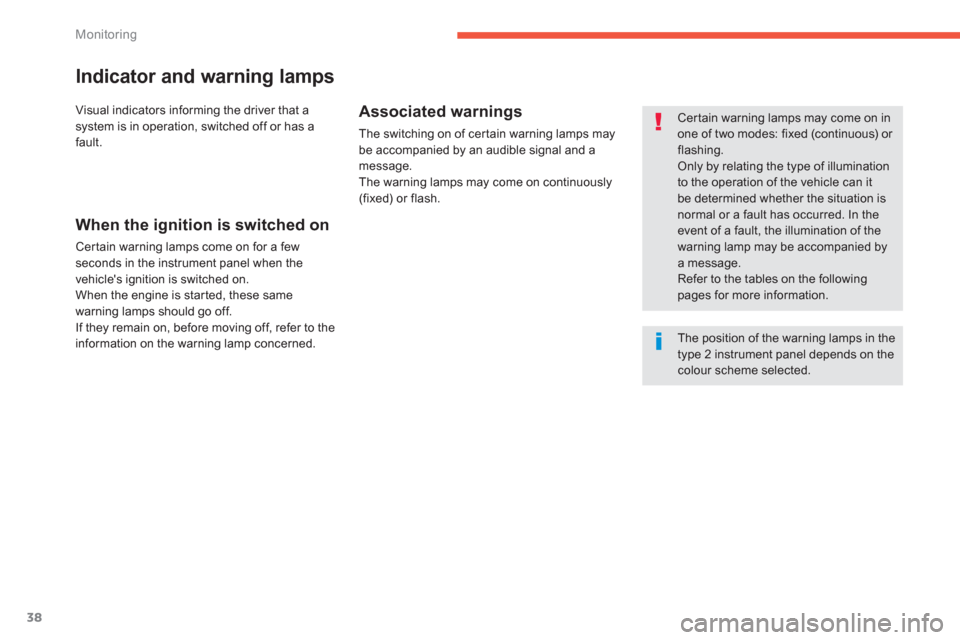
38
Monitoring
Indicator and warning lamps
Cer tain warning lamps may come on inone of two modes: fixed (continuous) or flashing.
Only by relating the type of illuminationto the operation of the vehicle can it be determined whether the situation isnormal or a fault has occurred. In the event of a fault, the illumination of the warning lamp may be accompanied bya message.
Refer to the tables on the following pages for more information. Visual indicators informin
g the driver that a system is in operation, switched off or has a
fault.
When the ignition is switched on
Certain warning lamps come on for a fewseconds in the instrument panel when the
vehicle's ignition is switched on.
When the en
gine is started, these same
warning lamps should go off.
If they remain on, before moving off, refer to the
information on the warning lamp concerned.
Associated warnings
The switching on of cer tain warning lamps may be accompanied by an audible signal and a
message.
The warning lamps may come on continuously (fixed) or flash.
The position of the warning lamps in the type 2 instrument panel depends on thecolour scheme selected.
Page 44 of 420
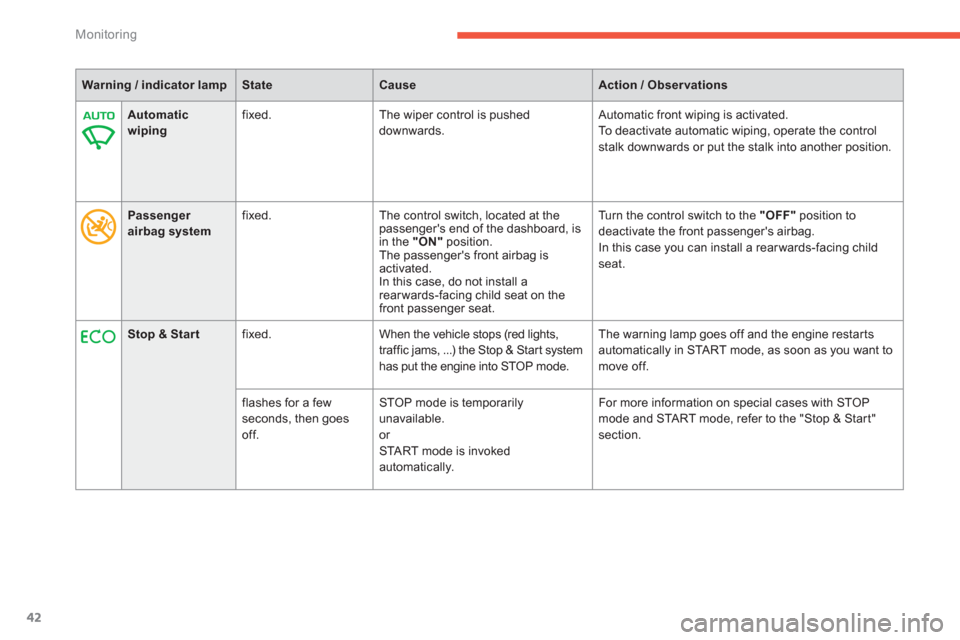
42
Monitoring
Warning / indicator lampStateCauseAction / Observations
Automatic wipingfixed. The wiper control is pushed downwards. Automatic front wiping is activated.
To deactivate automatic wiping, operate the controlstalk downwards or put the stalk into another position.
Passenger airbag systemfixed. The control switch, located at thepassenger's end of the dashboard, isin the "ON" position.
The passenger's front airbag is activated.In this case, do not install arearwards-facing child seat on the front passenger seat. T
urn the control switch to the "OFF"position to
deactivate the front passenger's airbag.
In this case you can install a rear wards-facing childseat.
Stop & Startfixed. When the vehicle stops (red lights,
traffic jams, ...) the Stop & Star t systemhas put the engine into STOP mode.The warnin
g lamp goes off and the engine restarts
automatically in START mode, as soon as you want tomove off.
flashes for a few seconds, then goes
off.
STOP mode is temporarily unavailable.
or STA R T m o d e i s i n v o ke dautomatically. For more in
formation on special cases with STOP mode and START mode, refer to the "Stop & Start"
section.
Page 61 of 420
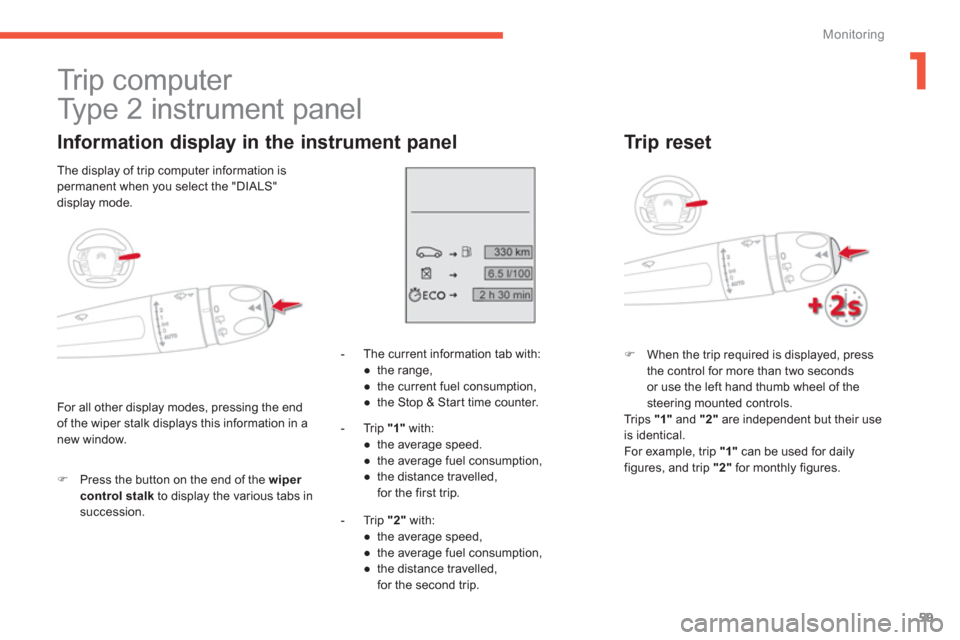
1
59
Monitoring
Tr i p c o m p u t e r
Type 2 instrument panel
Information display in the instrument panel
�)Press the button on the end of the wiper control stalk
to display the various tabs insuccession.- Th
e current information tab with:
●
the range,
●
the current fuel consumption,
●
the Stop & Star t time counter.
- Tr i p "1"
with:
●
the avera
ge speed.
●
the average fuel consumption,
●
the distance travelled, for the first trip.
-
Trip "2"
with:
●
t
he average speed,
●
the average fuel consumption,
●
the distance travelled,
for the second trip.
Tr ip reset
�)
When the trip required is displayed, press
the control for more than two secondsor use the left hand thumb wheel of the steering mounted controls.
Trips "1"
and "2"are independent but their use
is identical.
For example, trip "1"can be used for daily figures, and trip "2"for monthly figures.
For all other display modes, pressing the end
of the wiper stalk displays this information in anew window. The displa
y of trip computer information ispermanent when you select the "DIALS"
display mode.